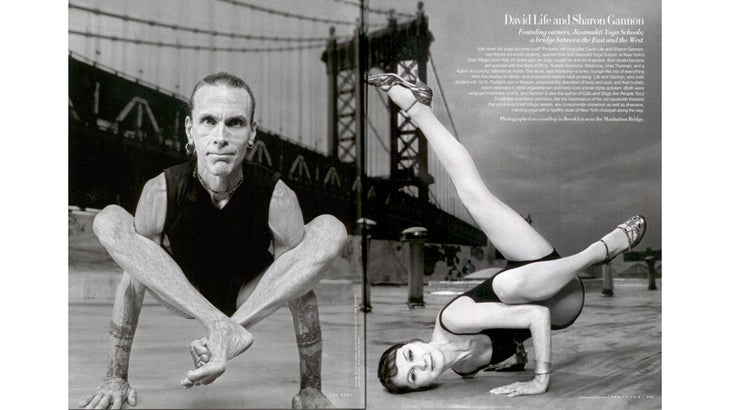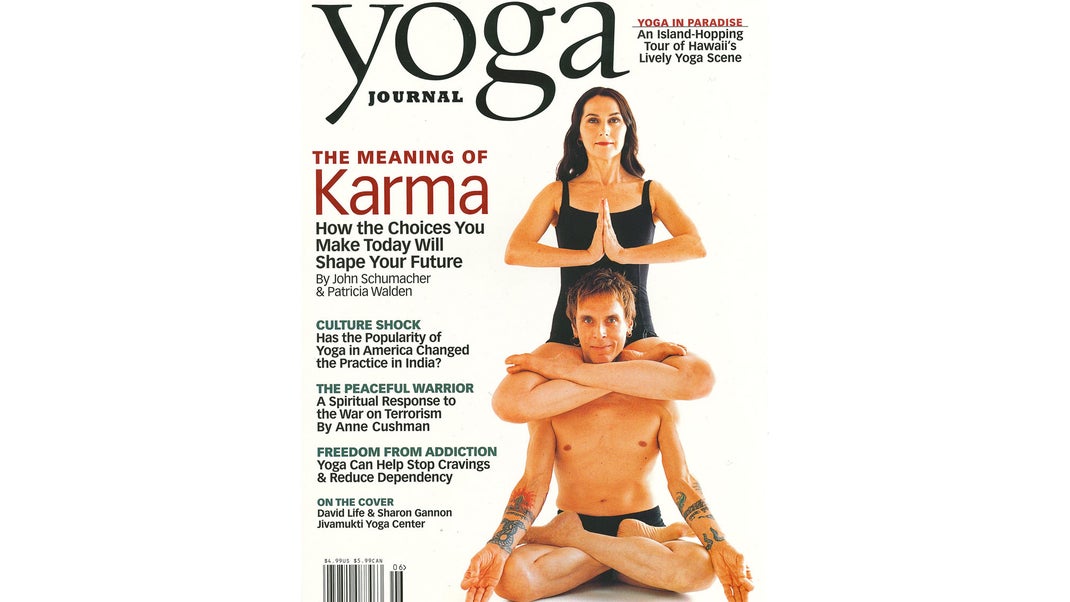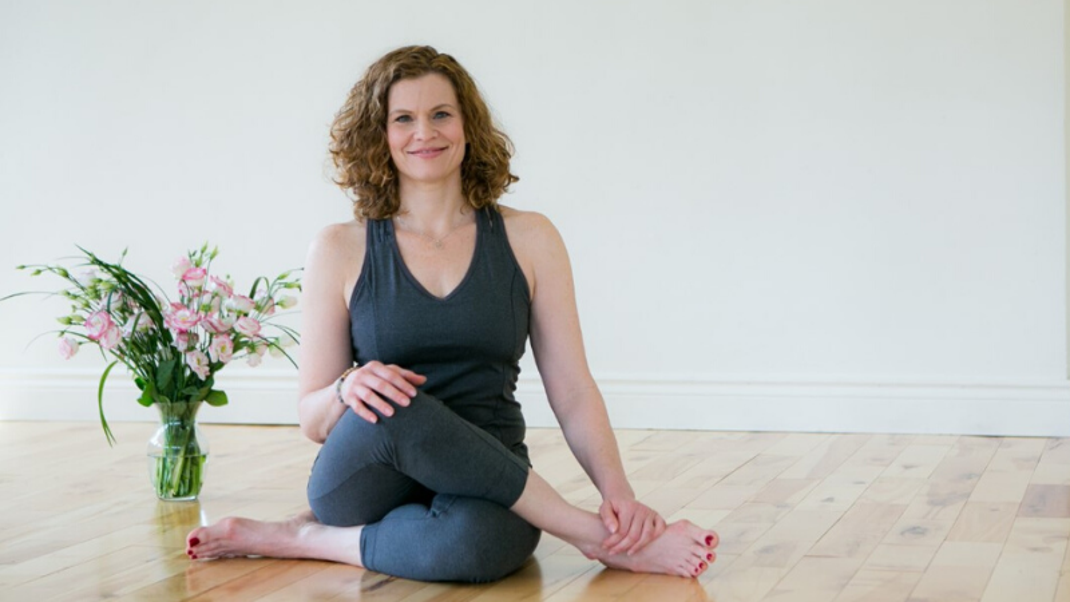The New York City yoga community has been saddened by the recent closure of The Yoga Loft. The space, which was home to more than just a studio and lounge, opened its doors in 2003 and is now closing them for good after 20 years. The owner of The Yoga Loft, Rachel Kranzler, wrote on their website: “It’s time to close The Yoga Loft.”
As long as there has been a New York City, there has been a Jivamukti, at least for me. When I first stepped off the plane in 1997 from California, hoping to penetrate the New York theater world, my dancer friend Kelly told me I had to go to a class. “It’s this amazing yoga studio,” she told me, “All the teachers are great, but you have to take a class with David or Sharon.” David Life and Sharon Gannon, I soon learned, were the studio’s founders. But what did Jivamukti mean? “Liberation in this lifetime,” Kelly responded.
The Second Avenue studio was inconspicuous on the outside, perched beside a Thai restaurant and jazz club called Purple Basil, but once you climbed the rickety steps to the second floor, you were hit by a waft of Nag Champa incense and the glow from Christmas lights bedecking images of saints, sadhus, and deities. A picture of Gandhi floated over a picture of Paramahansa Yogananda, whose image shared space with images of John Lennon, Mother Teresa, and Bob Dylan, and assorted Indian mystics, all wreathed in garlands atop a massive altar. This festive atmosphere was laden with a deeper meaning; the collective energy of devotion and meditation practically dripped off the fixtures.
The first time I visited, Kelly and I nudged through the throng of sweaty hipsters at the front desk, passing Willem Defoe as we purchased our classes and rented our mats, then made our way into the packed main studio. I felt like I was trying to find a patch of earth to sit on at a sold-out rock concert.
I realized my goal of hitting a New York City nightclub had been replaced: everything was going on here. A hush descended over the room as David entered, a beautiful lean man in a loincloth and not much else, exuding a piercing clarity that matched his blue eyes. He instructed us to sit upright in Sukhasana (Easy Pose). Following his cue, we raised our voices and the room resounded in a mighty “Om.”
Jivamukti Yoga Teachings
David then gave a dharma talk on the universal energies known as the gunas. “Everything is composed of these three energies,” he explained, “Tamas is slow and sluggish, and absorbed through eating meat or fat. Rajas are fiery, like caffeine, spicy food, or someone with a temper. Sattva is the highest vibration, the vibration of truth.” I thought about my caffeine consumption guiltily. David then explained that the more one practiced, the more one attained a higher energetic frequency, leading to a state known as sattvic. I resolved to head in that direction. Then we started moving. Form flowed into form as David led us in Sun Salutes, and from there into increasingly difficult combinations of poses.
Much to my astonishment, two-thirds of the way into class I found my inflexible body in full splits, or Hanumanasana. Our ending Savasana (Corpse Pose) was so deep and profound that elements of it are still embedded in my subtle energetic body to this day. I floated out after class, blissed out and sweaty. My fate was sealed.
I returned promptly the next day to take Sharon’s 10 a.m., worried I might not get a spot, as it frequently sold out. As subtle and understated as David had been, Sharon was equally magnetic and regal. Slender, pale, and elegant, with a red bindi dotted on her forehead. I thought she resembled one of the many goddesses hanging in frames on the wall. But which one? I scanned the female deities, trying to decide. She resembled them all, which I thought was interesting since she was clearly not from India. I started to wonder why she wore the bindi at all: Was she a practicing Hindu? (Today, dressing in traditional Indian garb might be viewed as cultural appropriation, but at the time, I interpreted it to be a sincere attempt to pay tribute to the culture from which yoga emerged, and in which David and Sharon had been immersed for over a decade). I pulled to attention as Sharon pulled the silk cover off the harmonium and we started chanting a Sanskrit mantra from laminated prayer sheets.
The topic was Gandhi and ahimsa, or non-violence. Sharon exhorted us to read his autobiography and directed the talk toward veganism. I began to realize that beneath Sharon’s serene exterior was a goddess-like ferocity. Then she cued us to start moving into the opening sequence.
Alice Coltrane’s “Journey in Satchitananda” flowed into a Beastie Boys’ song, followed by music from Sheila Chandra, Ravi Shankar, and Krishna Das, all orchestrated to elevate and drive us forward. Sharon, it turned out, was an awesome DJ. This eclectic mix reflected one of the core attributes that made Jivamukti so appealing: Indian culture was liberally mixed with the trappings of the East Village underground. Music was a huge part of the equation.
Another hallmark Jivamukti feature was hands-on assists. I welcomed Sharon’s touch, thrilled to be so directly acknowledged (these were different times when teachers didn’t ask if they could touch you first. This culture of hands-on adjustment is now under scrutiny, along with other aspects of the student-teacher relationship in yoga studios and styles. Jivamukti Yoga wasn’t immune to the scandals and allegations of misconduct that have plagued the yoga community). Sharon’s eye missed nothing, and though the class was packed, she managed to correct my alignment with a deft adjustment while peppering the class with directives: “Never underestimate your importance! One person can change the world!” I felt the power flow through her hands as she steadied my wobbly stance. Receiving an adjustment from Sharon was like a benediction; you felt it surge through you instantly like an electrical current. My body felt supercharged; my mind focused. After asana practice and Savasana, we sat upright to meditate. In these first two classes, I was introduced to the foundational aspects of the Jivamukti system:
- Shastra (scriptures)
- Bhakti (devotion)
- Ahimsa (nonviolence)
- Nada (music)
- Dhyani (meditation)
How Jivamukti Changed NYC Yoga
It is hard to convey how radical Jivamukti was. Yoga was the drab purview (at least in my mind) of health food store denizens and people rolling around on the floor in leotards. It was not fun, glamorous, or edgy; certainly not creative or artistic. The young people I knew didn’t do it voluntarily. At that time, yoga was largely stripped of its cultural heritage; poses were taught in English, and people were learning how to get into Headstand over 28 days on your living room floor from trade paperbacks like Richard Hittleman’s 28 Day Yoga, illustrated with black and white thumbnails. My mother had taken me to an ashram in California and I had chanted in Sanskrit before, but this was different: After the first two classes, I had the distinct impression I had found a home.
“The first time I came in with those Christmas lights, and Sharon was so beautiful playing the harmonium talking about what mattered, I found my home in the city, “ Says Colleen Saidman-Yee, a Jivamukti-trained teacher and co-founder of Yoga Shanti. “They were providing inclusivity for everyone. Sharon was always there. And they were downtown, in the lower chakra of the city!” Jivamukti did go through four downtown iterations, but after the opening of the Lafayette Studio, expanded to the Upper East Side with a smaller satellite studio.
David and Sharon studied with many teachers and absorbed many styles of yoga, taking Sivananda training, studying Ashtanga Yoga with its founder, Pattabhi Jois, and trekking upstate to Ananda Ashram in Monroe, New York, to absorb Swami Sarasvati’s teachings. David had spent time in India, taking vows to live as a sadhu. The intoxicating concoction of Jivamukti Yoga was their own inimitable blend of elements from all of these styles fused into one system.
They paired ruthless intellect with utter conviction, always within the context of a totally theatrical environment that balanced art, music, and activism, reflecting their own roots as artists deeply embedded in their East Village community. The milieu that gave rise to Jivamukti was an accurate reflection of the studio itself: diverse and radical downtown New York was as elemental in the shaping of Jivamukti as were the Indian teachers and traditions they venerated and espoused. This East Village aesthetic was not without appeal and often added a shot of edgy glamor. In one memorable photoshoot, Sharon posed in high heels and makeup while contorting in various advanced poses. The tacit message seemed to be that you could be a yogi and still be fabulous. To those who only associated yoga with granola and macramé, Jivamukti’s exhortations to bring activism and authenticity to yoga culture helped to empower the current yoga renaissance we are all enjoying today. Yoga mattered, and so did we.
 “It was very much a movement that came from the East Village art scene and the underground. We might not have found yoga without them,” says Kristin Leigh, co-founder of the Shala, and former longtime assistant and teacher at Jivamukti. “They had all the magic, esoteric elements—the art, the music, the ancient texts, the rituals, the activism.”
“It was very much a movement that came from the East Village art scene and the underground. We might not have found yoga without them,” says Kristin Leigh, co-founder of the Shala, and former longtime assistant and teacher at Jivamukti. “They had all the magic, esoteric elements—the art, the music, the ancient texts, the rituals, the activism.”
The Jivamukti Community
Jivamukti made yoga glamorous, and spirituality cool. Although celebrities frequented the studio, they did so as part of the family, unobtrusively, struggling to balance in Pincha Mayurasana (Feathered Peacock Pose) along with everyone else. All were invited to attend the studio’s many gatherings, such as kirtan and the legendary New Year’s Eve celebration. Retreats held at Ananda Ashram covered immersion themes such as Bhakti, or the yoga of devotion and provided an opportunity to dive deep. Jivamukti fostered community, and by extension, a home, for so many of us who were young and newly arrived in New York City. It became our solace and our refuge. “I would go several times a day, it became my routine,” says Dana Flynn, co-founder of Laughing Lotus Yoga Studio. “I had found my spiritual home. I wanted that awakening.” Says Dana Flynn.
The Jivamukti system’s emphasis on its five foundational pillars insured that its students could absorb the entire yoga practice, not just parts of it. It was like getting the manual to life. Ahimsa was particularly stressed as a fundamental principle of yoga. Once, Sharon stopped midway through the practice to roll out a video screen and project the Animal Movie, a radical animal-rights documentary showing images of graphic animal abuse and factory farming to incite us to veganism. After the class ended, she passed out a copy of “101 Reasons to be Vegan” to every student as they departed. I found it inspiring; We could change the world with our practice. I had a plan, a faith, and a community. Jivamukti expanded in popularity, garnering press and buzz. 1998, they left their tiny Second Avenue studio and moved to a huge 9,000 square foot studio on Lafayette Avenue across from the Public Theater and sold one-year memberships for $1,200.00, a significant financial outlay at the time. Though I couldn’t afford the membership, I volunteered to be a karma yogi, cleaning mats and folding towels in exchange for free classes.
Saidman-Yee recalls her teacher training experience at the Lafayette location. “I did the teacher training, but I thought I was only doing it to deepen my practice. I remember going to David and Sharon’s office and explaining that I couldn’t teach because I had a fear of public speaking. They listened very politely and seriously, and when I got home there was a message on my answering machine that I was teaching Sharon’s class, and it was sold out, and Sharon was taking it.”
The Cost of Running an NYC Yoga Studio
Jivamukti continued to grow, adopting a Jivamukti-branded model, opening their second New York City Jivamukti on the Upper East Side in 2000, and allowing Jivamukti certified teachers to operate Jivamukti-branded studios abroad (there are 11 international studios now, including Jersey City, Los Angeles, Berlin, Muncih, Barcelona, Sydney, London, and Schloss Elmau in Bavaria). Heady with success, Jivamukti moved again, in 2006, upsizing to a 2,000 square feet studio with a more central location near Union Square. They partnered with top vegan chef Matthew Kenney to create the Jivamuktea cafe. The partnership enabled them to divide the rent. They appeared to be supremely profitable, dominating the market. Teacher training provided a considerable source of revenue as well. The occasional activism stunt, such as the one where young, attractive teacher trainees posed in the semi-nude for a PETA campaign, helped promulgate the image of an edgy studio. Then, Matthew Kenney, bedeviled by financial issues, left his share of the space. A series of subsequent vegan cafes filled the void.
Without Kenney, Jivamukti was bound to a lease that was increasingly difficult to maintain. Meanwhile, rival studios proliferated all over town creating competition. To make matters more challenging, gyms encroached on the yoga market, hiring Jivamukti teachers to dispense training stripped of the more obvious devotional elements of yoga. And today, Classpass, the third-party class broker app, is cutting into yoga studio profits, making it difficult for many Manhattan studios. “When we opened Laughing Lotus, we hung out a shingle. No one worried about money or making rent back then,” says Flynn. “Now, it is increasingly difficult to maintain a space in New York City.”
When One Door Closes, Another Opens?
Although Jivamukti is closing the doors to its last New York City studio on December 22 (the Upper East Side location closed a few years ago), its presence continues to thrive in countless studios and teachers all over the world.
“There are some incredible new teachers and new teachings,” says Dechen Thurman, a Jivamukti teacher, and creator of his own yoga method, Graha Yoga. “The younger teachers have so many tools! Whether it’s called a Jivamukti class or it is someone who was a Jivamukti teacher who decided to rebrand for themselves, that quality, standard, and care will always be part of those lineages and those teachers. Yoga is in a great transition, in a post-lineage, modern-era, and Jivamukti will have a prominent place in the field for many years to come.”
Saidman-Yee agrees: “I remember my mission every time I walk up the steps to my studio in Tribeca. I remember what Sharon taught me.”
“Your yoga studio becomes your community, then becomes your family,” adds Leigh. “When I heard Jivamukti was closing, I felt sad. The yoga market has changed. We try to stay true to what we learned. ”
Sharon wrote in an email response to YJ about the closure: “We feel very grateful and blessed to have been able to have a yoga school in NYC for as long as we have—over 30 years! The lease for the current space on Broadway is near its end and it is time for us to close. But this doesn’t mean it is the end of Jivamukti Yoga. Who knows… Maybe a Jivamukti teacher will open a Jivamukti School in NYC sometime in the future.”
Conclusion:
The End of an Era for NYC Yoga The yoga market has changed. We try to stay true to what we learned. The lease for the current space on Broadway is near its end and it is time for us to close.



